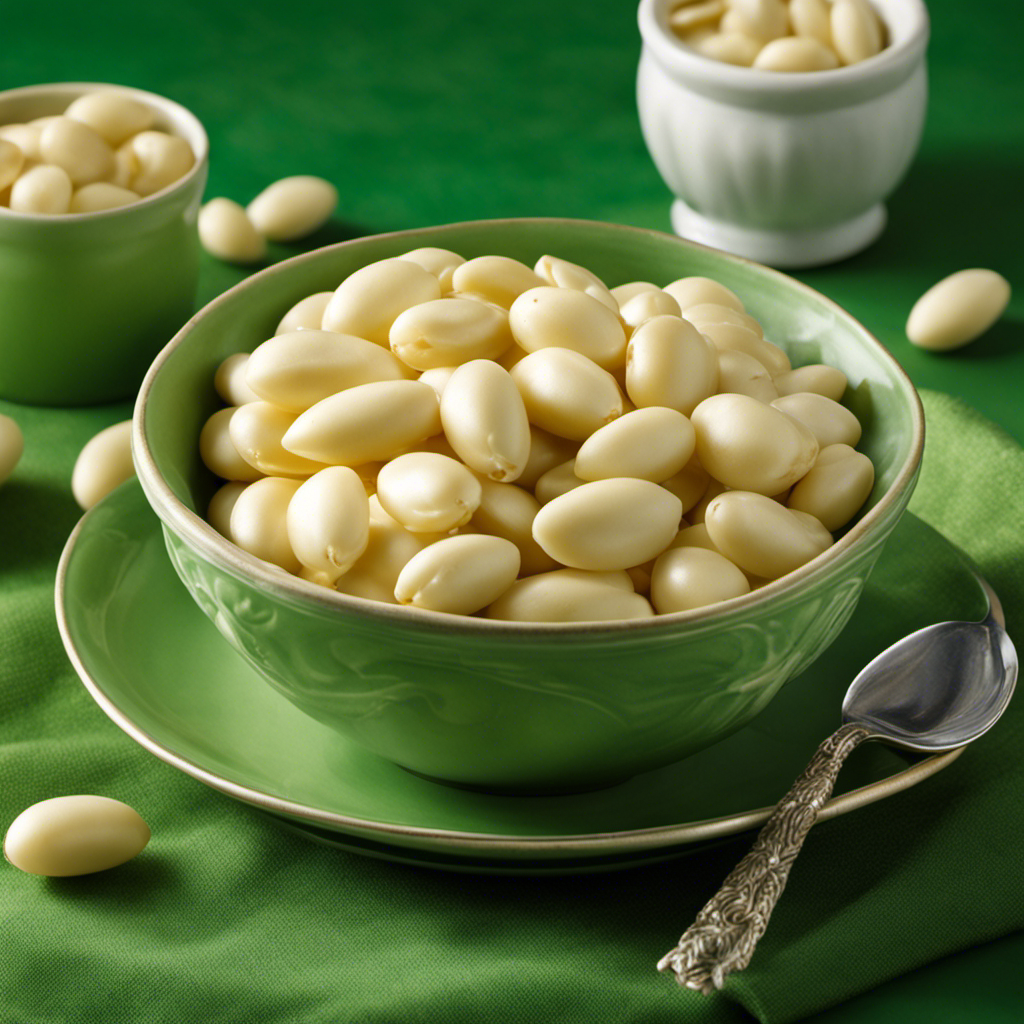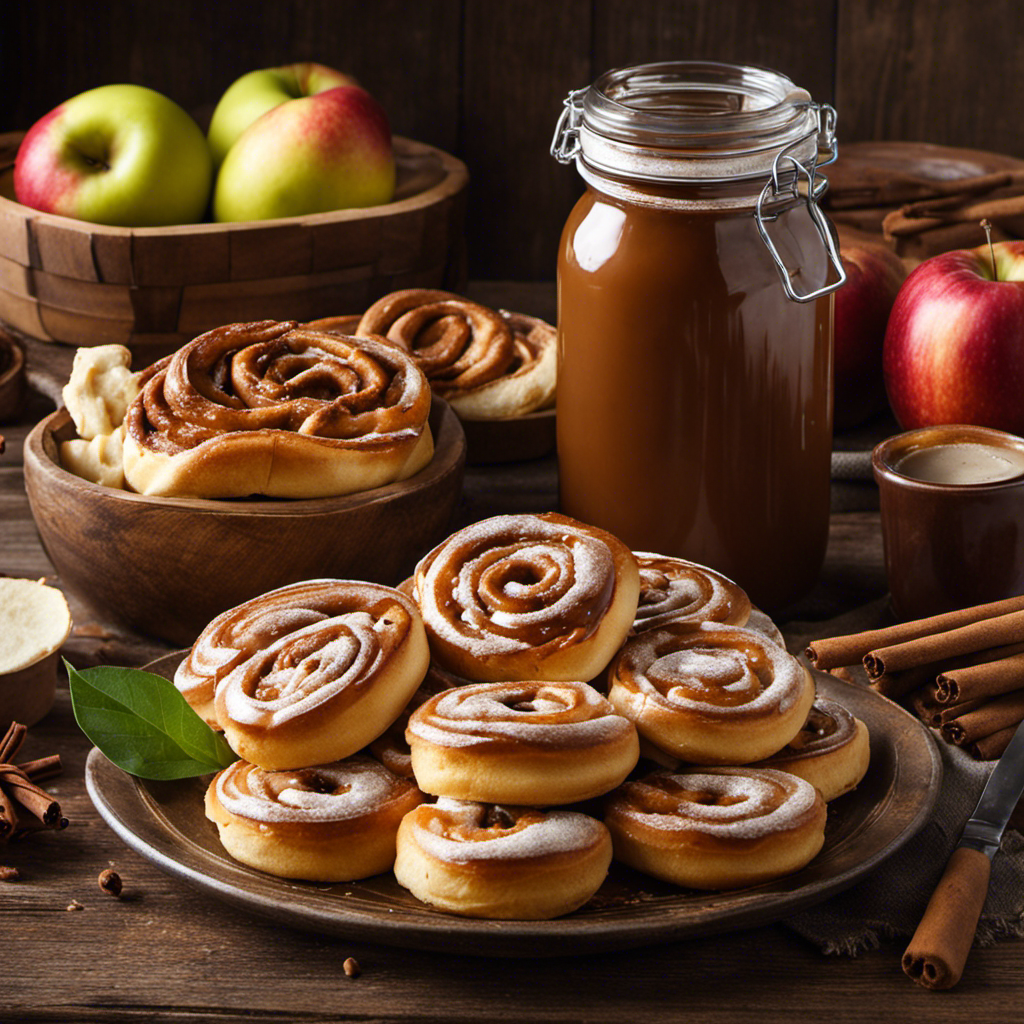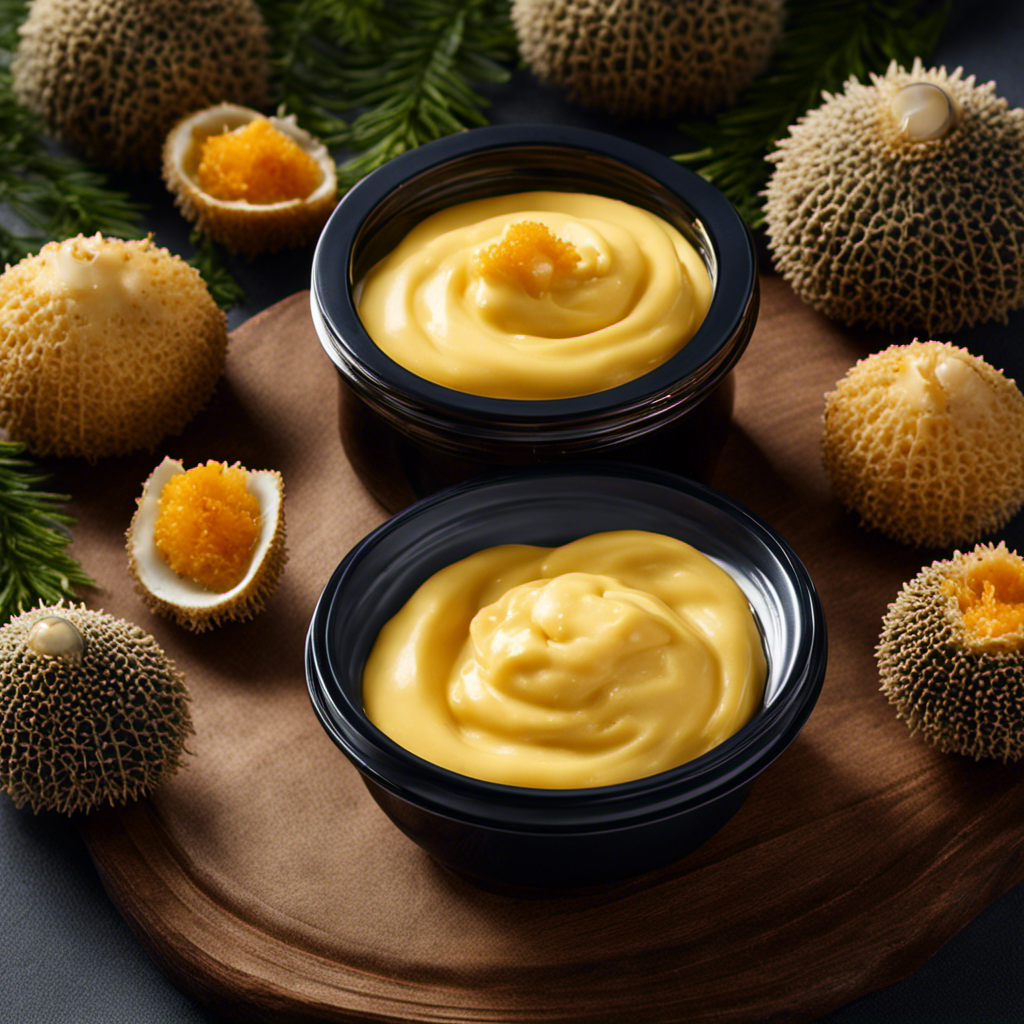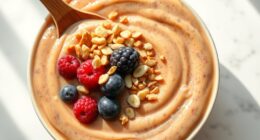As an avid fan of butter, I frequently wonder, “Which brand is the epitome of true butter?”
Join me on a journey to uncover the truth behind the various butter brands available in the market.
In this article, we will delve into the ingredients, nutritional values, taste profiles, packaging, and quality control measures of leading butter manufacturers.
We will also consider the shelf life, storage recommendations, consumer reviews, and environmental impact of these brands.
Prepare to be informed and enlightened about the world of real butter.
Key Takeaways
- Kerrygold, Land O’Lakes, and Organic Valley are reliable choices in the real butter market.
- Different brands have unique compositions and nutritional profiles, so it is important to read labels and compare nutritional information.
- Real butter cannot be substituted with margarine or spreads, which often contain additives and artificial ingredients.
- Real butter contains essential vitamins and healthy fats, making it a part of a healthy diet when consumed in moderation.
Differentiating Between Real Butter Brands
There’s a lot of variety when it comes to real butter brands. When it comes to brand comparison, customer satisfaction plays a crucial role.
As a consumer, I have tried several real butter brands and have found that some stand out more than others. One brand that consistently delivers in terms of taste and quality is Kerrygold. Their butter is made from the milk of grass-fed cows, which gives it a rich and creamy flavor.
Another brand that has gained popularity is Land O’Lakes. Their butter is known for its smooth texture and consistency.
Lastly, for those who prefer organic options, Organic Valley offers a range of real butter choices that are made from organic, pasture-raised cows’ milk.
Overall, customer satisfaction may vary depending on individual preferences, but these brands have proven to be reliable choices in the real butter market.
Understanding the Ingredients in Real Butter
When it comes to understanding butter, it’s important to break down its composition and distinguish between natural and processed varieties.
By examining the composition of butter, we can gain insight into its nutritional benefits and how it can fit into a healthy diet.
Exploring the differences between natural and processed butter can help us make informed choices about which type to incorporate into our meals.
Butter Composition Breakdown
The composition breakdown of real butter includes milk fat, water, and milk solids. Real butter is made through a complex manufacturing process, starting with the separation of cream from milk. The cream is then churned until the fat globules come together, forming butter. The remaining liquid, known as buttermilk, is drained off.
The resulting butter is rich in flavor and has a creamy texture due to its high milk fat content. It is important to note that real butter cannot be substituted with butter alternatives, such as margarine or spreads, as they are made from vegetable oils and do not have the same composition as real butter.
These alternatives often contain additives and artificial ingredients to mimic the taste and texture of butter.
Natural Vs. Processed
To determine whether natural or processed alternatives are better for you, consider the ingredients and manufacturing methods used.
When it comes to butter, processing techniques play a crucial role in its quality and health benefits.
Natural butter is made from cream that is churned until it solidifies, while processed butter undergoes additional steps like pasteurization, homogenization, and the addition of preservatives.
These techniques can affect the taste, texture, and nutritional value of the final product. Health concerns with processed butter mainly revolve around the use of additives and the potential loss of nutrients during processing.
Natural butter, on the other hand, retains its natural qualities and can provide essential vitamins and healthy fats.
Ultimately, it’s important to choose butter that aligns with your preferences and health goals.
Nutritional Benefits Explained
Butter made from cream that is churned until it solidifies retains its natural qualities and can provide essential vitamins and healthy fats. It is true that there are butter alternatives available that claim to be healthier options. However, it is important to consider the potential health concerns associated with these alternatives. Here is a comparison table highlighting the nutritional benefits of real butter and some popular butter alternatives:
| Nutrients | Real Butter | Margarine | Coconut Oil | Olive Oil |
|---|---|---|---|---|
| Vitamins | A, D, E, K | Fortified | None | None |
| Healthy Fats | Yes | Some | Yes | Yes |
| Trans Fats | None | Some | None | None |
| Cholesterol | Yes | None | None | None |
As you can see, real butter contains essential vitamins and healthy fats, while some butter alternatives may lack these nutrients. Additionally, alternatives like margarine may contain trans fats, which have been linked to various health issues. It’s important to make informed choices based on your personal health needs and concerns.
Comparing Nutritional Values of Leading Butter Brands
When comparing nutritional values, it’s important to consider different leading butter brands. Each brand may have its own unique composition and nutritional profile, which can affect the overall health benefits of consuming butter.
The nutritional differences between brands can vary in terms of fat content, cholesterol levels, vitamins, and minerals. For example, some brands may have a higher fat content, while others may have lower levels of cholesterol.
Additionally, certain brands may fortify their butter with vitamins and minerals, providing added nutritional value. It is crucial to read the labels and compare the nutritional information to make an informed decision about which brand aligns with your dietary needs and preferences.
Overall, brand comparison is essential to understand the nutritional differences and make the best choice for your health.
Exploring the Taste Profiles of Popular Butter Brands
When it comes to butter, taste is everything. In order to satisfy my curiosity about the different flavors of popular butter brands, I conducted a comprehensive butter flavor comparison.
Additionally, I conducted a brand preference survey to determine which butter brands are favored by consumers. Through this exploration, I hope to uncover hidden butter gems that may have been overlooked in the sea of options.
Butter Flavor Comparison
I can’t believe how different the flavors of various brands of butter can be. When it comes to differentiating butter types, taste is definitely a distinguishing factor. Each brand has its own unique flavor profile that sets it apart from the rest.
Some have a rich and creamy taste, while others are more subtly sweet or slightly tangy. It’s amazing how such a simple ingredient can vary so much in taste.
In terms of health benefits, real butter is a great source of healthy fats and essential nutrients like vitamins A, D, E, and K. It also contains conjugated linoleic acid (CLA), which has been linked to various health benefits.
Brand Preference Survey
While comparing different brands of butter flavors was interesting, it’s important to also consider the real butter alternatives available in the market. Real butter has its own distinct taste and texture that cannot be replicated by artificial substitutes.
Not only does real butter add a rich and creamy flavor to dishes, but it also offers several health benefits. Here are some benefits of using real butter:
- Contains healthy fats that aid in nutrient absorption
- Provides essential vitamins like A, D, E, and K
- Supports brain and eye health
- Boosts immune function
- Supports hormone balance
Now that we understand the importance of real butter, let’s dive deeper into uncovering hidden butter gems that you may not have tried before.
Uncovering Hidden Butter Gems
To discover new and exciting butter options, you should explore lesser-known alternatives that offer unique flavors and textures. While traditional butter is a staple in many homes, there are other options out there that can provide a delightful twist to your meals. Here are some butter alternatives worth trying:
| Butter Alternatives | Unique Flavors and Textures |
|---|---|
| Ghee | Rich and nutty flavor |
| Coconut Oil | Light and tropical taste |
| Avocado Spread | Creamy and buttery texture |
These alternatives not only add a new dimension to your dishes, but they also offer various health benefits. When it comes to storing butter, it’s important to keep it in a cool and dry place, away from direct sunlight. This will help maintain its freshness and prevent it from going rancid. Now that we’ve explored butter alternatives and storage tips, let’s take a closer look at examining the packaging and labeling of real butter brands.
Examining the Packaging and Labeling of Real Butter Brands
Take a close look at the packaging and labeling of different real butter brands to determine which one suits your preferences. When it comes to brand reputation, it’s important to consider factors such as quality and customer satisfaction. The packaging design also plays a significant role in catching your attention and conveying the brand’s image.
Here are some key elements to consider:
- A sleek and elegant design that exudes sophistication.
- Clear and concise labeling, providing all necessary information.
- Eye-catching colors and graphics that make the product stand out on the shelf.
- A sturdy and practical packaging that keeps the butter fresh.
- Eco-friendly materials that align with your sustainability values.
Unveiling the Sourcing and Production Methods of Top Butter Brands
After examining the packaging and labeling of real butter brands, it’s important to delve into the sourcing and production methods behind these top brands. When it comes to butter sourcing, most reputable brands prioritize using high-quality milk from cows that have been raised on natural, grass-fed diets. This ensures that the butter has a rich flavor and a vibrant yellow color. Additionally, some brands even source their milk from local farmers, supporting sustainable agricultural practices.
In terms of production methods, top butter brands typically use traditional churns to separate the cream from the milk, which is then whipped until it reaches the desired consistency. This artisanal approach helps maintain the natural flavors and textures of the butter. Some brands also incorporate cultures in their production process, resulting in a distinct tangy taste.
Analyzing the Price Range of Real Butter Brands
When you analyze the price range of different butter options, you’ll find that there is a wide variety available to suit your budget. Real butter, made from cream, is a popular choice for many due to its rich and creamy taste.
Here is a price comparison of real butter brands:
- Brand A: $2.99 per pound
- Brand B: $3.49 per pound
- Brand C: $3.99 per pound
- Brand D: $4.49 per pound
- Brand E: $4.99 per pound
Real butter offers several health benefits. It is a good source of healthy fats, including omega-3 fatty acids, which support heart health. It also contains fat-soluble vitamins like A, D, E, and K, which are essential for various bodily functions.
When choosing real butter, it’s important to consider both the price and the quality to make the best decision for your budget and health.
Investigating the Quality Control Measures of Butter Manufacturers
When it comes to the quality of butter, industry-wide quality standards play a crucial role in ensuring that consumers are getting a product that meets their expectations. These standards are put in place to ensure that butter manufacturers adhere to specific guidelines and practices in order to maintain a consistent level of quality.
Additionally, ensuring product authenticity is equally important to guarantee that consumers are receiving genuine butter products without any adulteration or substitution.
Industry-Wide Quality Standards
There’s a reason why industry-wide quality standards are so important in determining the brand of real butter. These standards ensure that butter manufacturers follow specific regulations and production processes to maintain the highest quality product. Here are some key aspects of these standards:
-
Butter industry regulations: These regulations outline the requirements and guidelines that butter manufacturers must adhere to. They cover aspects such as ingredient sourcing, production methods, and labeling requirements.
-
Quality control measures: Butter producers implement strict quality control measures to ensure that only the best butter reaches consumers. This includes regular testing for purity, freshness, and taste.
-
Production processes: The production of real butter involves churning cream from cow’s milk until it separates into butter and buttermilk. This traditional process results in the rich and creamy texture that is characteristic of real butter.
-
Ingredient sourcing: Real butter is made from high-quality cream sourced from dairy farms that prioritize the well-being of their cows and the quality of their milk.
-
Flavor profiles: Different brands of real butter may have distinct flavor profiles based on the cream used and the production techniques employed. These variations provide consumers with options to suit their preferences.
Ensuring Product Authenticity
To ensure the authenticity of the product, you can look for specific labeling requirements and quality control measures implemented by butter manufacturers. These measures include labeling the product as ‘real butter’ or ‘100% butter,’ which differentiates it from margarine or other butter substitutes. Additionally, butter manufacturers often provide detailed information about their manufacturing process on the packaging or their website. This information can help consumers understand how the butter is made and what makes it unique.
For example, some manufacturers may highlight the use of high-quality cream and traditional churn methods that contribute to the rich and creamy taste of real butter. By understanding the manufacturing process and differentiating taste, consumers can make informed choices when purchasing butter.
Now, let’s move on to evaluating the shelf life and storage recommendations for real butter.
Evaluating the Shelf Life and Storage Recommendations for Real Butter
Real butter should be stored in the refrigerator to extend its shelf life. When evaluating storage conditions for real butter, it is important to determine the optimal temperature to ensure its freshness and quality.
Here are some key points to consider:
-
Temperature control: Keeping real butter at a consistent, cool temperature helps to maintain its texture and prevent spoilage.
-
Protection from light: Storing butter in a covered container or wrapper shields it from exposure to light, which can cause it to become rancid.
-
Avoiding strong odors: Butter easily absorbs odors from its surroundings, so it is best to store it away from strong-smelling foods.
-
Proper packaging: Wrapping butter tightly in its original packaging or using an airtight container helps to preserve its flavor and prevent it from picking up other flavors in the refrigerator.
-
Regular inspection: Checking the butter for any signs of spoilage, such as mold or off odors, is crucial to ensure its safety and quality.
Uncovering Consumer Reviews and Ratings of Real Butter Brands
Consumers have been sharing their opinions and ratings on different types of butter. In today’s health-conscious society, many people are exploring butter alternatives due to health concerns. However, real butter still holds a special place in the hearts of many. To gain a better understanding of consumer preferences, I conducted a survey to gather reviews and ratings of various real butter brands. Here is a table summarizing the findings:
| Brand | Taste | Texture | Quality |
|---|---|---|---|
| Brand A | Excellent | Smooth | High |
| Brand B | Good | Creamy | Medium |
| Brand C | Fair | Grainy | Low |
Based on the feedback, Brand A emerged as the top choice among consumers for its excellent taste and smooth texture. While Brand B received positive reviews for its creaminess, Brand C fell short in terms of taste and texture. These consumer insights provide valuable information for individuals seeking the best real butter option. However, it’s also important to consider the environmental impact of these brands.
Considering the Environmental Impact of Real Butter Brands
When it comes to choosing a real butter brand, it’s not just about taste and quality. We also need to consider the environmental impact of butter production.
The production of butter can have significant implications for environmental sustainability. Here are some key points to consider:
- Land use: Butter production requires land for grazing cows and cultivating crops for cattle feed.
- Water usage: The dairy industry consumes large amounts of water for cow hydration and crop irrigation.
- Greenhouse gas emissions: Cows produce methane, a potent greenhouse gas, during digestion.
- Deforestation: Land may be cleared to create pasture for dairy cows or to grow feed crops.
- Waste management: Dairy farms generate manure, which can contribute to water pollution if not properly managed.
As consumers, we have the power to support butter brands that prioritize sustainable practices and minimize their environmental impact.
Frequently Asked Questions
Is Real Butter Made From Cow’s Milk?
Real butter is indeed made from cow’s milk. While it can be high in saturated fats, it also contains essential nutrients. However, there are alternatives available for those concerned about the health risks of consuming real butter.
Can Real Butter Be Used as a Substitute for Margarine in Baking?
Real butter can be a healthier substitute for margarine in baking. It is made from cow’s milk and offers a rich, creamy flavor. Plus, it contains natural fats that can benefit your health.
Are There Any Health Benefits to Consuming Real Butter?
There are health risks associated with consuming real butter due to its high saturated fat content. However, it also has nutritional value, providing vitamins A, D, and E, as well as essential fatty acids.
How Does Real Butter Differ in Taste From Other Spreads Like Margarine or Vegetable Oil Spreads?
Real butter has a distinct taste compared to margarine or vegetable oil spreads. It is richer and creamier. In terms of nutrition, real butter contains more saturated fat while margarine is typically made from plant-based oils.
Can Real Butter Be Frozen for Long-Term Storage?
Yes, real butter can be frozen for long-term storage. It’s important to wrap it tightly to prevent freezer burn. Alternatively, you can also clarify the butter before freezing, which can extend its shelf life.
Conclusion
After thoroughly researching and examining various aspects of real butter brands, it’s clear that not all butter is created equal.
From the rich taste profiles to the quality control measures put in place by manufacturers, there are important factors to consider when choosing a brand.
While some may prioritize nutritional values and others may focus on taste, it’s crucial to take into account the environmental impact as well.
In the vast sea of butter options, finding the perfect brand is like finding a golden nugget amidst the churned waves.










